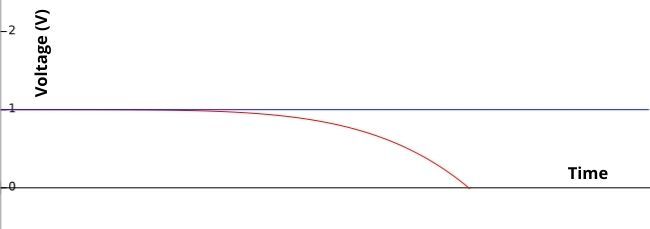There are two types of current/voltage – AC (Alternating Current) and DC (Direct Current). Thus, when you are working with electronics, you must know about those two types. Therefore, this article will teach you about the differences between AC and DC, how they work, as well as some additional facts.
What is AC (Alternating Current)?
In short, AC is current/voltage that changes over time. This type of power is the one that comes out of the sockets inside and around houses. If you drew a Voltage-Time graph, it would look something like this sine wave:

As you can see in this graph, the voltage changes over time and even gets into the negative region. As a result, the voltage, the polarity, and the flow of the electrons (current flow) change.
Because of the alternating current flow, we cannot store Alternating Current.
If we talk about the voltage of an alternating current, we refer to the maximum voltage the sine wave reaches.
In the following, I am going to explain what the frequency of AC power means.
Frequency
The frequency determines how often a cycle repeats within a second. The frequency is measured in Hz (Hertz).
For instance, the frequency of the graph above is 1Hz because it has exactly one cycle per second.
The usual frequency of AC power in houses is between 50Hz and 60Hz. Due to that high frequency, we cannot see our lights flicker even though the voltage changes all the time.
Examples for AC
- Electrical power in houses
- Electric Vehicles
- Different kinds of electric motors
- Analog signals
What is DC (Direct Current)?
In short, DC, compared to AC, is a current/voltage that “doesn’t change” over time. This means that the power source doesn’t change its polarity. For example, the voltage of a usual AA battery drops over time. However, the AA battery is still considered a DC source as it doesn’t change its polarity.
The following image shows a simplified Voltage-Time graph of a DC source that drops in voltage over time and a DC source that is completely steady:

Examples for DC
- Batteries
- Electric Vehicles
- Different kinds of electric motors
- Computer
- Charger for your phone
How to convert AC to DC?
We can convert AC to DC with a very simple circuit that consists of 4 diodes and a capacitor. Such a circuit is called a rectifier.
The circuit for a simple rectifier looks like this:

We use four diodes to remove the negative voltages and turn them into positive values. However, only the four diodes would give us a Time-Voltage graph like this one:

To fix this problem and get an almost constant current, we simply need to add one or multiple capacitors like in the circuit above. Now, the result should look something similar to this:

Disclaimer: If you decide to build this circuit on your own, always have a look at the specifications and limits of your components. Building this circuit is at your own risk!
Conclusion
In conclusion, AC (Alternating Current) changes its polarity over time, whereas DC (Direct Current) does not. Additionally, AC changes its voltage in form of a sine wave, whereas DC does not change its voltage or, at least, doesn’t get into negative values.
We can convert AC to DC with a rectifier and DC to AC with an inverter.
| Alternating Current (AC) | Direct Current (DC) |
|
|
Thanks for reading!

